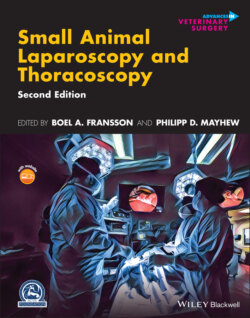Читать книгу Small Animal Laparoscopy and Thoracoscopy - Группа авторов - Страница 127
Waveforms
ОглавлениеThere are three basic types of waveforms generated in electrosurgery: Cutting waveform, coagulation waveform, and blended waveforms (Figure 5.2). Cutting waveforms are continuous waveforms, and coagulation and blended are intermittent waveforms.
The continuous cutting waveform uses less peak voltage at a similar power setting to the intermittent waveform, resulting in less lateral thermal tissue damage. With pure cut, the amplitude of the continuous waveform is the same. This induces a localized effect on the tissues, creating high tissue temperatures (>100 °C), vaporization of the interstitial fluid, and tissue separation with little hemostasis. Heat is absorbed by water released from the cells, which minimizes thermal damage and provides minimal coagulation. Power settings for the cut waveform are often between 50 and 80 W [4].
The intermittent waveform of the coagulation waveform produces a high current density delivered in pulses. This waveform has a higher voltage than the continuous waveforms and delivers the electrical charge deeper into the tissues. The pauses between the pulses lead to decreased tissue heating, resulting in coagulation rather than cutting. Coagulation is achieved with a power setting between 30 and 50 W [4]. Coagulation can either be performed using desiccation or fulguration. Whereas fulguration uses a noncontact technique to control diffuse hemorrhage, desiccation is a contact technique used for local bleeding. Fulguration uses an intermittent waveform, which allows for proteins to melt and recongeal, forming a coagulum. Some ESUs also contain a spray mode, which is useful for oozing capillary beds. Spray mode does not penetrate as deeply into tissues and can be used in more delicate tissues. Desiccation or a contact technique leads to less heat production than fulguration. A coagulum is formed by tissues drying out and proteins melting.
A blended waveform results in simultaneous coagulation and cutting. Whereas blend 1 is more effective at cutting with minimal hemostasis, blend 3 results in better hemostasis and decreased cutting (see Figure 5.2). Many surgeons prefer to use the blend waveform because it provides a trade‐off between thermal tissue damage and hemostasis.
Despite its name, the cutting waveform can be used for coagulation, and in some scenarios, it is recommended over the coagulation waveform. An example is when applying electrosurgery to the hemostat or forceps in what is referred to as coaptive coagulation. In this scenario, cutting energy is recommended because this produces deeper hemostasis and less thermal spread compared with coagulation energy. Coagulation results in rapid increase in impedance from char at the electrode. As impedance increases, more power is needed to penetrate deeper tissues. Instead, cutting energy heats up the tissue more quickly, minimizing char accumulation and allowing energy to penetrate deeper into the target tissues. With coaptive coagulation, the flattened vessel wall becomes fused as the current is applied to the instrument. Heat denatures the outer vessel wall and dehydrates the vessel, halting blood flow.
Figure 5.1 Most electrosurgery units operate within the medium radiofrequency electromagnetic spectrum. Some units operate at a higher radiofrequency (3–4 MHz) and are referred to as radio wave radiosurgery.
Source: From Huhn [3].
Figure 5.2 Pure cut is a continuous low‐voltage waveform. Coagulation waveform is a high‐voltage intermittent waveform that allows for cooling between energy pulses. Blended waveforms provide a continuum of intermittent waveforms of varying voltages, which allow for a tissue effect more geared toward cutting or coagulation.
Source: From Huhn [3].
